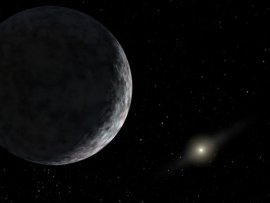|
Astronomers have found a new planet in the
outer reaches of the solar system.
by Dr Tony Phillips
"It's definitely
bigger than Pluto." So says Dr. Mike Brown of the California
Institute of Technology who announced on July 29th 2005 the discovery
of a new planet in the outer solar system.
The planet, which hasn't
been officially named yet, was found by Brown and colleagues using
the Samuel Oschin Telescope at Palomar Observatory near San Diego.
It is currently about 97 times farther from the sun than Earth,
or 97 Astronomical Units (AU). For comparison, Pluto is 40 AU from
the sun.
This places the new
planet more or less in the Kuiper Belt, a dark realm beyond Neptune
where thousands of small icy bodies orbit the sun. The planet appears
to be typical of Kuiper Belt objects--only much bigger. Its sheer
size in relation to the nine known planets means that it can only
be classified as a planet itself, Brown says.

An artist's
concept of the new planet.
|
Backyard astronomers
with large telescopes can see the new planet. But don't expect to
be impressed: It looks like a dim speck of light, visual magnitude
19, moving very slowly against the starry background. "It is
currently almost directly overhead in the early-morning eastern
sky in the constellation Cetus," notes Brown.
The planet was discovered
by, in addition to Brown, Chad Trujillo, of the Gemini Observatory
in Mauna Kea, Hawaii, and David Rabinowitz, of Yale University,
New Haven, Connecticut. They first photographed the new planet with
the 48-inch Samuel Oschin Telescope on October 31, 2003. The object
was so far away, however, that its motion was not detected until
they reanalyzed the data in January of this year. In the last seven
months, the scientists have been studying the planet to better estimate
its size and its motions.
"We are 100 percent
confident that this is the first object bigger than Pluto ever found
in the outer solar system," Brown adds.
Telescopes have not
yet revealed the planet's disk. To estimate how big it is, the astronomers
must rely on measurements of the planet's brightness. Like all planets,
this new one presumably shines by reflecting sunlight. The bigger
the planet, generally speaking, the bigger the reflection. The reflectance,
the fraction of light that bounces off the planet, is not yet known.
Nevertheless, it is possible to set limits on the planet's diameter:
"Even if it reflected
100 percent of the light reaching it, it would still be as big as
Pluto," says Brown. Pluto is 1400 miles (2300 km) wide. "I'd
say it's probably [about] one and a half times the size of Pluto,
but we're not sure."
The size of the planet
is further limited by NASA's Spitzer Space Telescope, which has
already proved its mettle in studying the heat of dim, faint, faraway
objects such as the Kuiper-belt bodies. Because Spitzer has been
unable to detect the new planet, the overall diameter must be less
than about 2000 miles (3200 km), says Brown.
The planet's temporary
name is 2003 UB313. A permanent name has been proposed by the discoverers
to the International Astronomical Union, and they are awaiting the
decision of this body before announcing the name. Stay tuned!
|
